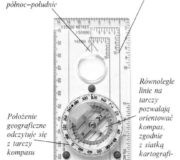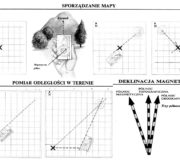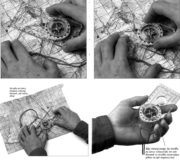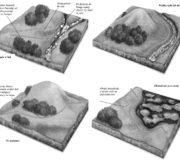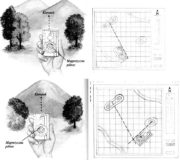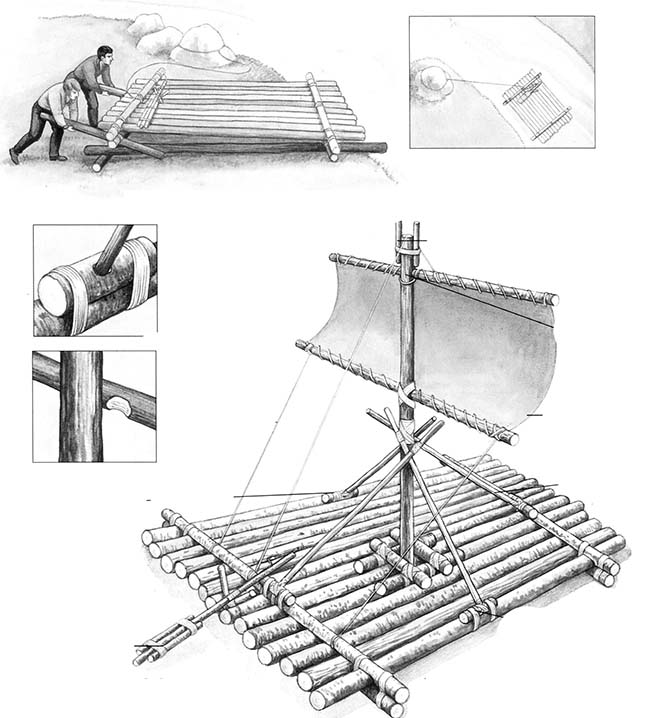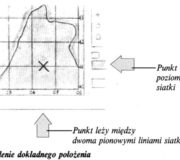WYZNACZANIE STRON ŚWIATA WEDŁUG SŁOŃCA
Słońce rozpoczyna zawsze swą pozorną wędrówkę po niebie na wschodzie, a kończy na zachodzie. Pozwala to łatwo określić strony świata. Wystarczy, że słońce jest widoczne i znamy porę dnia. Można również wyznaczyć przybliżone kierunki stron świata sporządzając prowizoryczny zegar słoneczny lub posługując się zegarkiem jako kompasem.
Półkula północna – Skieruj krótką wskazówkę zegara na słońce. Wyznacz w myśli linię będącą dwusieczną kąta wyznaczonego przez krótką wskazówkę zegara i godzinę dwunastą. Linia ta wskaże południe.
Półkula południowa – Skieruj zegarek godziną dwunastą na słońce. Dwusieczna kąta ograniczonego prostą przechodzącą przez godzinę dwunastą oraz krótką wskazówkę zegarka wyznacza północ.
ZEGAR SŁONECZNY – Wbij prosty kij pionowo w ziemię. O brzasku zaznacz koniec cienia, rzucanego na ziemię (zachód na półkuli północnej). Przywiąż do kija sznurek o długości cienia oraz zakreśl na ziemi luk wokół niego. Zaznacz miejsce, gdzie wieczorem (wschód), cień styka się z łukiem.
WYZNACZANIE STRON ŚWIATA WEDŁUG GWIAZD
Gwiazdy na niebie nigdy nie zmieniają położenia względem siebie. Wydają się jedynie przesuwać po nieboskłonie wraz z ruchem Ziemi. Tylko jedna gwiazda jakby stale znajdowała się w tym samym miejscu – to Gwiazda Polarna. Widoczna na półkuli północnej wskazuje północ. Na półkuli południowej południe wyznacza się za pomocą Krzyża Południa.
Półkula północna – Znajdź na niebie gwiazdozbiór Wielkiego Wozu (Wielkiej Niedźwiedzicy). Potem przeprowadź w myślach linię łączącą tylne koła wozu. Gwiazda polarna znajduje się na tej samej linii w odległości około cztery razy większej niż odległość między gwiazdami-kołami wozu. Ta jasna gwiazda wisi nad horyzontem dokładnie nad punktem wskazującym północ.
Półkula południowa – Odszukaj na niebie gwiazdozbiór nazywany Krzyżem Południa. Wzdłuż ramienia krzyża przeprowadź w myślach linię około cztery i pół raza dłuższą od odległości między gwiazdami wyznaczającymi to ramię. Południe znajduje się poniżej końca tej linii. Dwie gwiazdy poniżej Krzyża Południa pomogą wyznaczyć właściwy punkt na niebie.
OKREŚLANIE STRON ŚWIATA NA PODSTAWIE OBSERWACJI PRZYRODY
Rośliny i zwierzęta bardziej niż człowiek dostrajają się do naturalnego porządku w przestrzeni determinowanego stronami świata. Rośliny zwracają się zawsze w stronę słońca – na półkuli północnej na południe, południowej – na północ. Słoneczniki obracają swe kwiaty śledząc jakby pozorny bieg słońca po niebie. Roślina – Biegun Północny z Ameryki Południowej pochyla się w kierunku północy. Słoje wskazujące na coroczny przyrost grubości pni drzew są zawsze szersze od strony, z której świeci słońce (od południa na półkuli północnej).
Termitiery – Niektóre termity wznosząc termitiery orientują te imponujące budowle zgodnie z osią północ-południe. W ten sposób są one mocno ogrzewane przez słońce rano i wieczorem, podczas gdy w południe pozostają w cieniu.
Tkacze – Pewne gatunki ptaków pomagają w określaniu stron świata. Na przykład pochodzące z podrodziny tkaczy budują gniazda wyłącznie po zachodniej stronie drzew. Jeśli znajdujesz się na obszarze będącym siedliskiem tych ptaków, na przykład w południowej Afryce, możesz spokojnie polegać na ich wyczuciu stron świata.

